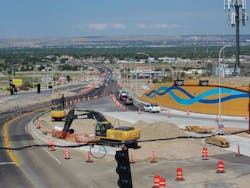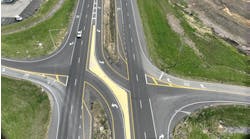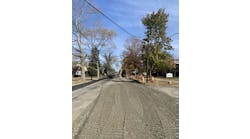By: Tim Bruns
Anyone traveling along the I-25/Rio Bravo Boulevard Interchange in Albuquerque, New Mexico, might notice the unique design work of multicolored ribbons woven together against a canvas of concrete retaining walls.
The design appears to perhaps signify a river, a reasonable assumption since the Rio Grande itself flows through the Albuquerque region. However, the design is meant to reflect another significant feature of the state. “At first we thought it was for the river,” Erick Garcia, project manager for AUI Inc., told Roads & Bridges. “But after, we were able to get ahold of the architect, and they said it was for the clouds—the skyline. Because New Mexico always has blue skies; we have sunshine 90% of the year out here. So that’s why they used the different shades of blue and made it into ribbons to represent the skyline.”
Originally constructed in 1961 and serving as the major gateway into Albuquerque South Valley and the Mesa Del Sol Development, the I-25/Rio Bravo Interchange was identified by the New Mexico DOT (NMDOT) as one of the top five transportation projects in the state. The reconstruction of the interchange was designed to improve safety by improving traffic flow, reducing congestion, and expanding I-25 from four to six lanes as well as improving safety by providing enhanced ramps from Rio Bravo Boulevard to I-25. Work also improved storm drainage and replaced aging bridges along the corridor.
The interchange is a major commuter route that serves around 50,000 vehicles on a daily basis. For the reconstruction of I-25/Rio Bravo, NMDOT opted for a single-point interchange, the first of its kind in the state. Typically, this type of interchange is designed to help move large volumes of traffic through limited space safely and efficiently. This type of intersection has the advantage of allowing opposing left turns to proceed simultaneously by compressing the two intersections of a diamond into one single intersection over or under the free-flowing highway. “So before, there used to be an intersection on both sides of the interstate—one to go north, one to go south—and it all would come into a single point,” Garcia said. “So now the southbound off-ramp—when there are vehicles there—can turn a green light to go eastbound on Rio Bravo without affecting the eastbound on-ramp for northbound. And when there’s traffic coming out from the northbound off-ramps, it pauses the signals, but it all works as one.”
Construction spanned a total of five phases for the I-25/Rio Bravo project. A major milestone for the work included the realignment of the intersection itself in addition to the widening of westbound Rio Bravo Boulevard. The interchange required a new layout at the I-25/Rio Bravo intersection, with new roadway pavement and features within the right-of-way, including multimodal improvements. The Rio Bravo corridor itself was widened to accommodate six lanes instead of four as it approaches the intersection. New bridges were also constructed in different phases for both I-25 westbound and southbound.
Single heavy-highway projects exceeding $25 million are not common for New Mexico, and the contractor faced a number of major challenges—including managing traffic and the installation of temporary shoring. The priority to reduce impacts to traffic meant performing a majority of paving operations overnight for AUI Inc. “People were continuously using the intersection, so we did a lot of closures at night to keep the public moving,” Garcia explained. “We had hired a PR person to make sure they were in contact with the public at all times. We did radio advertisements, we had a website—everything going to make sure everyone was informed. I don’t think we impacted traffic that much because we hardly got any bad responses while we were working out there. We had two lanes of traffic flow at all times.”
The temporary shoring was used to construct a new retaining wall as well as a new box structure to serve as the new northbound off-ramp, and the shoring was adjacent to live traffic in a limited work area. In order to build the northbound off-ramp—which is a box structure that goes underneath the interstate—the team had to drive sheet piling there and subsequently place southbound traffic onto the northbound side of traffic. “So we had to create a detour to widen out northbound so we could accommodate four lanes—two lanes coming in, two lanes going out—to construct that area,” Garcia said. “And then we had to drive sheet piles on that too. And we drove 50- to 65-ft sheet piles to retain the earth to keep northbound traffic flowing. And once we did that, we were able to construct the northbound off-ramp section—the tunnel section—which was a big box culvert. But we had to excavate down to 40 ft to make that work. Once we built that side, we threw everybody on the southbound side and built the northbound lanes.”
During the course of the project, nearly 1 million cu yd of dirt were excavated in total. The excavation process proved to be a challenge due to project phasing, as phases of the project were running concurrently while not always using or removing dirt at the same rates. AUI proposed a solution to this issue by stockpiling material currently on the site and using it where it was needed at a later time as opposed to removing it and needing to excavate additional material.
The creation of the retaining wall structures proved to be an obstacle itself on the project, as the unique ribboned artwork design selected for the walls was time-consuming for the contractor to complete. “The challenge of building it was getting the pattern done correctly because we cut all the form ourselves to fit what was on the design,” Garcia explained. The custom forms were created and engineered in the field to create the look and finish required for the design. “All the field measurements were given out to our guys, who were able to lay everything out without a hitch. So just installing the formline and lining it and all that stuff was pretty time-consuming.”
The completion of this project marks the largest that AUI Inc. has ever constructed, which is all the more impressive that the contractor finished up work a week in advance of expected completion. The reconstructed I-25/Rio Bravo Boulevard Interchange was opened to traffic in the first week of July 2019.
Project: I-25 / Rio Bravo Boulevard Interchange
Location: Albuquerque, New Mexico
Owners: New Mexico DOT
Designer: AECOM
Contractors: AUI Inc.
Cost: $55 million
Length: 2.5 miles
Completion Date: July 2019
About The Author: Bruns is associate editor of Roads & Bridges.




